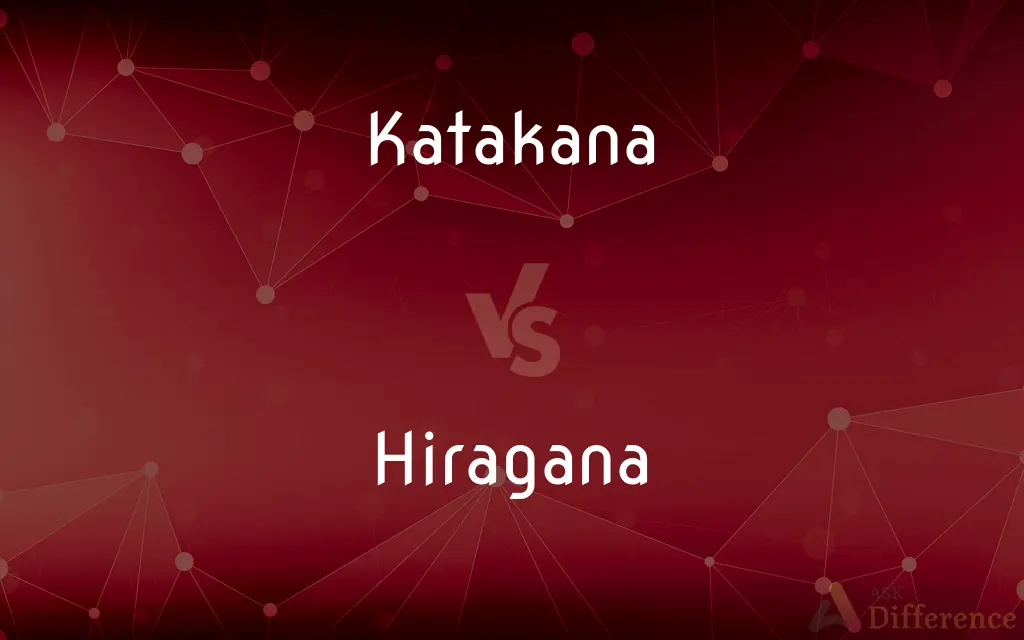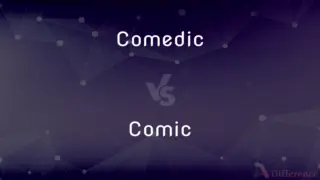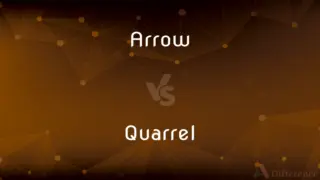Katakana vs. Hiragana — What's the Difference?
By Fiza Rafique & Maham Liaqat — Updated on March 26, 2024
Katakana is primarily used for foreign loanwords and onomatopoeia, while Hiragana serves as the foundation for native Japanese words and grammatical functions.

Difference Between Katakana and Hiragana
Table of Contents
ADVERTISEMENT
Key Differences
Katakana and Hiragana are both components of the Japanese writing system, complementing each other in functionality and usage. Katakana is often used for foreign loanwords, onomatopoeia, technical and scientific terms, and names of plants, animals, minerals, and often for emphasis. Hiragana, on the other hand, is used for native Japanese words not covered by kanji and for grammatical elements such as particles and verb endings. This distinction allows readers to quickly determine the nature of the words used in a text.
In terms of appearance, Katakana characters are generally more angular and simpler than Hiragana characters. While Katakana tends to have fewer strokes and more straightforward designs, Hiragana characters are more rounded and complex. This difference in style reflects the distinct roles they play in Japanese writing, with Katakana often signaling foreign or specialized content, whereas Hiragana integrates seamlessly with the more traditional kanji characters for a fluid reading experience.
Learning and mastery of both Katakana and Hiragana are essential for literacy in Japanese. Beginners usually start with Hiragana, given its integral role in constructing sentences and its use in conjugating verbs and adjectives. Katakana, while equally important, is typically learned after Hiragana due to its specific use cases. This progression from Hiragana to Katakana mirrors their functional hierarchy in the language.
Pronunciation between Katakana and Hiragana is consistent, as they represent the same set of sounds. However, the context in which they are used can influence the perceived pronunciation, especially for Katakana words derived from foreign languages, which may adopt an approximation of the original foreign pronunciation. This aspect underscores the adaptability of the Japanese language in incorporating foreign terms.
The writing practice for both Katakana and Hiragana involves specific stroke orders and directions, which are crucial for handwriting recognition and aesthetics. Although the stroke order is similar for corresponding sounds in both scripts, mastering their distinct forms requires practice and understanding of their unique applications in Japanese text.
ADVERTISEMENT
Comparison Chart
Usage
Foreign loanwords, onomatopoeia, technical terms
Native Japanese words, grammatical elements
Appearance
Angular, simpler characters
Rounded, more complex characters
Learning Sequence
Typically learned after Hiragana
Usually the first script learned by beginners
Pronunciation Influence
May adopt approximations of foreign pronunciations
Primarily used for native Japanese pronunciation
Stroke Order and Direction
Specific, similar to Hiragana for corresponding sounds
Specific, emphasizes traditional Japanese handwriting techniques
Compare with Definitions
Katakana
Katakana is used for foreign loanwords.
コーヒー (kōhī) for coffee.
Hiragana
Hiragana is used for native Japanese words.
さくら (sakura) for cherry blossom.
Katakana
Katakana is employed for technical and scientific terms.
コンピュータ (konpyūta) for computer.
Hiragana
Hiragana provides phonetic readings for kanji.
かわいい (kawaii) for cute.
Katakana
Katakana is used for naming certain plants, animals, and minerals.
サメ (same) for shark.
Hiragana
Hiragana is essential for children's literature and beginner texts.
あいうえお (aiueo) for learning basic sounds.
Katakana
Katakana marks onomatopoeia and sound effects.
ワンワン (wanwan) for a dog's bark.
Hiragana
Hiragana represents grammatical elements such as particles.
は (wa) as the topic marker.
Katakana
Katakana can denote emphasis similarly to italics.
マジで? (Maji de?) for Really?
Hiragana
Hiragana is used for verb and adjective conjugations.
たべます (tabemasu) for eat in polite form.
Katakana
Katakana (片仮名、カタカナ, Japanese pronunciation: [katakaꜜna]) is a Japanese syllabary, one component of the Japanese writing system along with hiragana, kanji and in some cases the Latin script (known as rōmaji). The word katakana means "fragmentary kana", as the katakana characters are derived from components or fragments of more complex kanji.
Hiragana
Hiragana (平仮名,ひらがな, Japanese pronunciation: [çiɾaɡaꜜna]) is a Japanese syllabary, one component of the Japanese writing system, along with katakana, kanji and in some cases Latin script. It is a phonetic lettering system.
Katakana
A relatively angular kana used especially to write foreign words, onomatopoetic words, and the names of plants and animals in Japanese.
Hiragana
The cursive and flowing variety of kana used in most modern Japanese texts especially to represent inflectional endings and particles.
Katakana
(uncountable) A Japanese syllabary used when writing words borrowed from foreign languages other than Chinese, specific names of plants and animals and other jargon, onomatopoeia, or to emphasize a word or phrase. Also used to write the Ainu language.
Hiragana
(uncountable) The main syllabary for the Japanese language, used to represent native Japanese words, including particles, and when kanji is used, to represent verb and adjective endings.
Katakana
A character thereof.
Hiragana
A letter of this syllabary.
Common Curiosities
What is Hiragana used for?
Hiragana is used for native Japanese words and grammatical functions.
What is Katakana used for?
Katakana is used for foreign loanwords, onomatopoeia, and technical terms.
Can Katakana and Hiragana pronunciation differ?
Pronunciation is consistent, but Katakana may use approximations for foreign words.
How do Katakana and Hiragana characters differ visually?
Katakana characters are more angular and simpler, while Hiragana characters are more rounded and complex.
Are Katakana and Hiragana interchangeable in Japanese writing?
No, they serve different purposes and are not interchangeable, with Katakana used for foreign terms and Hiragana for native words and grammar.
Is it possible to write Japanese using only Hiragana or Katakana?
Technically yes, but it's uncommon and can make text difficult to understand. Japanese typically uses a mix of Hiragana, Katakana, and Kanji for clarity.
Do Katakana and Hiragana cover the same set of sounds?
Yes, both alphabets represent the same set of phonetic sounds in the Japanese language.
How many characters are in the Katakana and Hiragana syllabaries?
Both Katakana and Hiragana have 46 basic characters, not including diacritics and digraphs.
In what order are Katakana and Hiragana usually learned?
Hiragana is typically learned first, followed by Katakana.
How does the use of Katakana affect the pronunciation of foreign words?
Katakana words often approximate the pronunciation of foreign words within the constraints of Japanese phonetics, sometimes resulting in significant differences from the original pronunciation.
Share Your Discovery

Previous Comparison
Comedic vs. Comic
Next Comparison
Arrow vs. QuarrelAuthor Spotlight
Written by
Fiza RafiqueFiza Rafique is a skilled content writer at AskDifference.com, where she meticulously refines and enhances written pieces. Drawing from her vast editorial expertise, Fiza ensures clarity, accuracy, and precision in every article. Passionate about language, she continually seeks to elevate the quality of content for readers worldwide.
Co-written by
Maham Liaqat













































